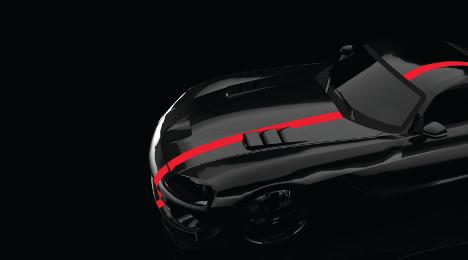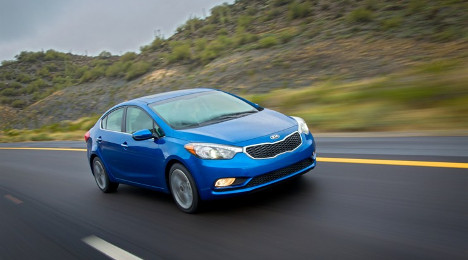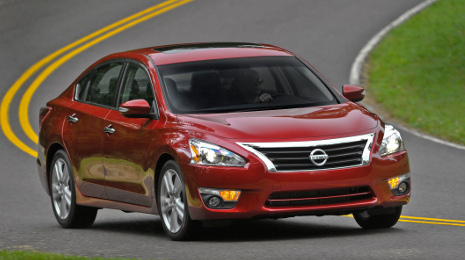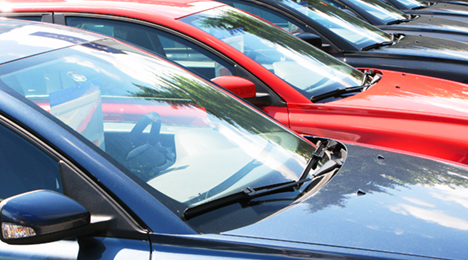Certified pre-owned sales continue to climb and hit records. And used-car inventories are getting younger at franchised dealerships, with 58 percent of their used-car inventory in the second quarter at 3 years old or newer, according to Edmunds.com.
In its Q2 2016 Used Vehicle Market Report, Edmunds said 22.6 percent of franchised dealers’ used-car sales in the second quarter were CPO units. This was on par with Q2 of 2015, when 22.9 percent of their used sales were certified.
So that begs this question: If CPO sales are at record highs and franchised used-car inventory is skewing younger, why has CPO share of franchised dealers' used-car sales only remained flat? And will that share increase as the year goes on?
The team at Edmunds looked into those questions and shared some insight, pointing out that certified vehicles tend to take longer to sell because of their higher prices.
“So, yes, we are getting many lease returns (and expect more in the future) but the time horizon in which they sell is longer and more volatile,” a company spokesperson said in an email.
“Cheap used cars sell quick and easy. Expensive used cars, not so much. The relationship between franchise used and CPO may not always look the same quarter to quarter,” the spokesperson said.
However, you can expect increases in the CPO share of franchised used down the road.
It’s a “two-fold effect,” according to Edmunds. Not only are there more cars coming off lease, there has been a slowdown in the percent of new-car buyers who bring a trade-in through the front door.
In the second quarter, 45 percent of new-car sales had a trade-in, according to Edmunds. That is down from 48 percent a year ago and 51 percent as recently as Q2 2012.
April through June represented the best second quarter ever for certified pre-owned sales, according to Edmunds.com, which said dealers sold 678,169 CPO units.
This beat year-ago figures by 2.6 percent.
Used-car inventories are getting younger at franchised dealerships, cars are coming off lease and CPO sales continue to break records.
Certified has become a bigger part of franchised dealers' used-car operations than in the early half of the 2010s, but it is relatively even with last year in terms of sales share.
In its Q2 2016 Used Vehicle Market Report released Thursday, Edmunds said 22.6 percent of franchised dealers’ used-car sales in the second quarter were CPO units.
This was on par with Q2 of 2015, when 22.9 percent of their used sales were certified.
“We do expect CPO units to increase in sales, but so far this year the mix with standard used sales has stayed flat with last year,” Edmunds said in the report.
In the second quarter of previous years, CPO has commanded 18.8 percent (2011), 18.0 percent (2012), 19.9 percent (2013) and 20.5 percent (2014) shares of franchised used sales.
Franchised inventory younger
Along those same lines, the percentage of franchised dealers’ used-car inventory that is 3 years old or newer has steadily moved north in the last four years.
In the second quarter of this year, 58 percent were in this age bracket.
It dipped from 48 percent in Q2 2011 to 44 percent in Q2 2012, but it has climbed gradually each year. Half of franchised dealers' used inventory was 3 years or younger in Q2 of 2013, and that share has been above 50 percent in the second quarter of every year since.
Not surprisingly, this is largely being driven by off-lease volume, which continues to rise.
And so, too, will this age group’s share of used inventory.
“As the influx of lease returns impacts the market, we see that the share of 3 years old or younger vehicles sold at dealerships continues to pace well above 50 percent,” Edmunds said in the report. “At this rate, we should expect to see the share of near-new vehicles hit 60 percent by the end of the year.”
In the latest installment of the annual Power 300 issue of Auto Remarketing, we go behind the scenes with some of the leading companies in the used-car space and their top executives with a few Q&A features.
Next up in this series is Tom DeLuise, the national Toyota Certified and Rent A Car sales and operations manager at Toyota Motor Sales, U.S.A.
Auto Remarketing: What are some challenges dealers face in CPO, and how are they working to overcome those challenges?
Tom DeLuise: There are a lot of moving pieces in the car business, and it takes attention to detail to run a successful CPO/used vehicle operation. There are many challenges dealers face with CPO such as availability of vehicles that meet certification requirements. Toyota dealers are mining their lease return portfolio, service drive and are taking advantage of TFS (Toyota Financial Services) online auction sales for vehicle acquisition.
Another challenge for dealers is to get cars in and out and front line ready within two to five days of acquisition. Dealers are constantly working to improve and speed up the reconditioning process. This includes hiring more techs, extended hours and shifts, and additional facility capacity.
(Another challenge is) proper pricing of cars to the market and repricing vehicles at the appropriate time. Many dealers review the market and adjust prices every week. Many Toyota dealers are utilizing inventory tools such as vAuto to remain competitive in the market.
AR: Toyota rolled out CPO leasing in January. How has this been received, and do you predict a significant increase in the program?
TD: Toyota started certified lease training with our dealers in January. Our strategy was to provide the dealer another finance tool to sell TCUV (Toyota Certified Used Vehicles) and was designed to provide the customer another payment option in addition to a traditional retail contract. There are certain vehicles, based on time and mileage, that leasing will work as a viable option for the customer.
Prior to January, our leasing was less than 1 percent. We projected leasing could move into the 5 percent to 8 percent range. We are currently running around 3 percent.
AR: Toyota’s CPO program posted its best sales month of all time in March. (Per Autodata Corp., Toyota moved 38,563 CPO vehicles; this beat year-ago figures by 23.2 percent.) To what do you attribute this great success?
TD: First and foremost, our dealers have truly bought into the value of TCUV and have done a tremendous job in selling that value to our customers. We have stepped up our TCUV training courses over the past two years. The courses are for our sales associates as well as a managers’ class that pulls all the critical players from the dealership into one room to review the “TCUV Value Story.”
Like all OEMs, we have a steady supply of lease returns that have fueled our growth and will continue to supply our dealers with high-quality inventory. In addition, our partnership with TFS has been invaluable. TFS supports the dealers with products, programs and a commitment to help the dealer sell cars. It’s a team effort and that’s the critical piece that in needed in order to get it done.
AR: What do you see as customers’ top impressions of CPO?
TD: Customers see the value in TCUV. It is peace of mind for them because they know the vehicle is backed by Toyota. Customers are looking for QDR (quality, durability, reliability). Combine that with the 160-point certification process and it helps build value.
Additional pieces from this series can be found below:
4 questions with AUL's Jimmy Atkinson
Q&A with Jared Rowe
4 questions with Costo Auto Program's Lori Grone
4 questions with Tony Hughes of Moody’s Analytics
4 questions with NABD's Ken Shilson
The amount of off-lease inventory flowing into Kia’s certified pre-owned program will likely double this year. That’s proving fruitful for a brand that just finished its best two months ever for CPO sales.
And, most likely, the CPO market as a whole.
In July, Kia moved 7,007 certified units for a 20.6-percent year-over-year gain, according to Autodata Corp.
The automaker said in a news release Monday that this marked the second-best month it has ever had for CPO.
No. 1? That was June. Kia sold 7,403 CPO cars that month (up 21 percent).
Like much of the industry, increases in off-lease volume have helped drive nice gains in certified sales for Kia, which said its CPO numbers were up 12 percent in the first four months of 2016.
Year-to-date, Kia is up 14.8 percent with 43,935 CPO sales.
In June, Kia was joined in the record-breaking ranks by Land Rover, which also posted its best-ever month for CPO, according to Autodata.
In July — which was the second-best CPO month of all time for the industry itself — five brands (BMW, Lexus, MINI, Nissan and Subaru) reached best-ever sales, Autodata said. All told, there were 234,243 certified sales, beating last July’s figure by 5.6 percent, the firm said.
There have been 1.56 million certified vehicles sold so far this year (a 4.1-percent increase, Autodata said) and comments from Autotrader’s senior analyst in Kia’s news release suggest the industry could go much higher.
“CPO sales growth will skyrocket in the near future, approaching 3 million in the next couple of years and surpassing 4 million by the end of the decade,” Michelle Krebs said.
“A robust CPO program will be critical to automakers and their dealers to build sales and customer loyalty, and maintain strong residual values for leasing customers and buyers trading in their vehicles,” she added.
One of the ways in which automakers can drive more of the off-lease volume to CPO is through the lower mileage allotments on leases, says Edmunds.com.
In the company’s Lease Market Report for the first half of 2016, Edmunds said that the average annual mileage on leases has fallen steadily in the past 11 years: It dipped from 13,060 miles in the first half of 2005 to 11,990 miles in the first half of this year.
Lower mileage allotment “leads to better condition of off-lease vehicles, which can command higher used prices,” Edmunds said in the report.
“Low miles also lead to a greater possibility of CPO-able vehicles, which allows automakers to have a hand in used vehicle profits,” it adds.
July was the second-best month of all time for certified pre-owned car sales, Autodata Corp. said Thursday.
The industry sold 234,243 CPO vehicles last month, which beat year-ago figures by 5.6 percent, the firm reported. The only month stronger was March, when 243,957 certified vehicles were sold.
Five brands (BMW, Lexus, MINI, Nissan and Subaru) reached best-ever sales, Autodata said.
July’s daily sales rate of 9,009 marked just the third time the DSR has exceeded 9,000, according to the firm.
Through seven months, there have been 1.56 million CPO sales, which is up 4.1 percent year-over-year.
After selling 77,287 CPO units in July (down 2.2 percent), domestics have now moved 550,570 vehicles year-to-date (down 0.3 percent).
Asian brands sold 118,939 certified vehicles in July (up 13.7 percent) and had seven-month sales of 755,715 (up 10.4 percent).
European brands have moved 252,582 CPO units so far this year (down 2.9 percent), after selling 38,017 in July (down 0.8 percent).
BMW sold a record 11,877 certified pre-owned vehicles in July, beating year-ago figures by 23.1 percent, the company said in a news release Tuesday.
Meanwhile, the MINI brand at BMW Group U.S. posted a July record 1,197 CPO sales, which beat year-ago sales by 8 percent.
Among other brands reporting July CPO results so far, Mercedes-Benz increased certified sales by 8.8 percent, selling 10,517 units in July.
Its year-to-date tally is at 70,863 CPO sales (up 3.4 percent).
Toyota Motor Sales USA said in a news release that the Lexus L/Certified brand had its strongest July on record. Its sales climbed 24 percent.
Mazda sold 3,540 certified vehicles in July, up from 3,437 a year ago.
Through seven months, it has sold 22,606 CPO vehicles, down from 23,807 through July 2015.
At Volkswagen, CPO sales for July were at 5,688 units (down 31.8 percent), while year-to-date sales are at 43,291 units (down 22.2 percent).
Audi sold 4,066 certified vehicles last month.
Stay tuned to Auto Remarketing for additional and industry CPO sales numbers as they are released.
Certainly automakers and dealerships want buyers to pay a premium retail price for a certified pre-owned vehicle stemming from the reconditioning and other costs associated with the unit. But are consumers ready to pony up the extra cash or willing to finance that additional cost?
The latest survey from NADA Used Car Guide gave OEMs and managers some tangible data.
As a part of NADA Used Car Guide’s 2016 Certified Pre-Owned Consumer survey, consumers were asked to select a dollar amount they would be willing to pay for a CPO vehicle above and beyond a non-CPO used vehicle. The question was prefaced with a series of common CPO program benefits — comprehensive inspection and reconditioning requirements, an extended bumper-to -bumper warranty, etc. — to help respondents assign value.
Taken as a collective, analysts found the largest chunk of respondents (39 percent) were willing to pay up to $1,000 more for a CPO vehicle versus a non-certified used vehicle.
However, analysts noticed a sizable 31 percent of participants stated they weren’t willing to pay any premium for a CPO vehicle.
The remaining portion of responses were spread between a $1,000 to $2,000 premium to a more than $4,000 premium.
As might be expected, CPO premium results were much different when the data is grouped by the likelihood of a future CPO purchase. Of those stating they were, “likely” or “extremely likely” to consider purchasing a CPO vehicle, 44 percent said they would pay up to $1,000 more versus a non-certified vehicle. Just 11 percent said they would pay nothing.
In addition, 22 percent stated they would pay $1,000 to $2,000.
Although the sample size is somewhat small — 181 participants to be exact — NADA UCG indicated 36 percent of luxury vehicle consumers said they would pay a premium of up to $1,000, while 32 percent would pay $1,000 to $2,000.
Just 8 percent of self-proclaimed luxury buyers wouldn’t pay any premium.
“Given that NADA Used Car Guide mainstream and luxury brand CPO premiums currently average $1,190 and $2,160, respectively, consumer feedback among those willing to buy a CPO vehicle is generally in line with where premiums are actually transacting,” analysts said in their August Perspectives that was dedicated to summarizing the survey data.
Of those claiming neutral intent toward a CPO purchase, NADA UCG pointed out the vast majority (44 percent) once again were willing to spend up to $1,000. In contrast, a sizable 28 percent weren’t willing to pay anything above and beyond the cost of a typical used vehicle.
“Not surprisingly,” according to analysts, premiums were much lower for individuals claiming they were either unlikely or extremely unlikely to consider a future CPO purchase, with nearly 60 percent stating they would pay nothing.
“It should be noted that premium results based on purchase likelihood were generally similar when viewed by age, gender and level of CPO familiarity,” NADA Used Car Guide said.
In light of that cost premium information — along with what Auto Remarketing previously reported about CPO awareness — NADA Used Car Guide tried to explain what it all means for dealers and automakers. The summations came from two regular participants who are coming back to this year’s Used Car Week, which runs from Nov. 14 to 18 at the Red Rock Resort and Casino in Las Vegas.
Jonathan Banks, executive analyst at NADA Used Car Guide said, “What the data tells us is that there is an opportunity for the industry to make consumers more aware of the availability of manufacturer certified pre-owned vehicle programs.”
Larry Dixon, senior manager of market intelligence at NADA Used Car Guide added, “There is also an opportunity to educate consumers on the benefits of CPO vehicle ownership and why it may be worth paying more over a non-certified used vehicle.”
Sales of certified pre-owned vehicles are setting records. But a study commissioned by NADA Used Car Guide found consumer awareness about CPO programs still has plenty of room to improve.
In a special report shared with Auto Remarketing on Tuesday, NADA UCG determined 50 percent of 18- to 34-year-olds who participated in the survey stated they were either slightly, or not at all, familiar with CPO programs.
For older consumers, the findings were a little better.
Analysts noted only 40 to 44 percent of respondents (35- to 75-plus years old) reported similarly low familiarity with CPO programs.
NADA UCG indicated the gender of survey respondents correlated to a greater divide in certified pre-owned vehicle awareness. According to results in the August Perspective report:
• More than one third of male respondents indicated they were slightly, or not all, familiar with CPO programs.
• 39 percent of male respondents felt moderately to extremely familiar with certified pre-owned programs.
• 23 percent of male respondents reported being somewhat familiar with CPO programs.
Analysts pointed out women were less knowledgeable, with nearly 60 percent expressing little to no familiarity with the certified vehicle purchase option. Also, fewer than 25 percent of female respondents felt they were moderately or extremely familiar with CPO programs.
NADA UCG continued the survey by asking “What type of vehicle will you consider buying in the future?” The prospects for CPO was a bit dim as the findings went this way:
• 8 percent of respondents declared they would only consider buying CPO in the future.
• 17 percent stated they would strictly shop for new vehicles.
• 44 percent answered they would strictly buy used vehicles.
While the number of CPO-only shoppers was small, analysts mentioned 27 percent of respondents stated their willingness to consider CPO alongside either a new or used vehicle.
NADA UCG also asked, “How likely are you to consider purchasing a certified pre-owned vehicle in the future?” Analysts found that 52 percent of 18- to 34-year-old respondents stated they were neutral in their commitment to a future CPO purchase.
NADA Used Car Guide’s 2016 Certified Pre-Owned Consumer survey was conducted on NADAguides.com from May 27 to June 3.
Editor’s note: Stay tuned for another report detailing survey results regarding what premium consumers are willing to pay for CPO models.
Summer barbeque season brings out summer barbeque conversations. I was gathered around the barbeque with friends when the discussion became heated.
The topic? No, it wasn’t the merits of grilling with charcoal versus gas but whether to buy or lease a car. It’s a hotter topic today than ever since we’re looking at an estimated 3.1 million vehicles coming off lease in 2016. Where are these cars going and what is the best way to move the vehicles while holding residuals and profits?
To determine which option is best, buy or lease, let’s look at both, and to make things even more interesting, let’s see how certified pre-owned (CPO) factors into the equation.
Lessees act more like used-car buyers than new
First, the perception: Many consumers assume that leasing is for new cars only. What they overlook is that leasing is simply an alternative way of financing a vehicle. Leasing a used vehicle works exactly the same as with a new car; the biggest difference is that the monthly payments will likely be less. Cox Automotive research shows that once they go to the dealership, lessees act more like used buyers than new, focused more on the deal than the vehicle.
For the dealership, the challenge is getting approval for a used-car lease. Since 2008, writing leases on pre-owned vehicles has become tight from lenders. A dealer is more likely to get funded through a captive lender and on a certified pre-owned vehicle.
Used-car leases follow the same basic structure as new-car leases. The lender writing the lease will determine the vehicle’s residual value, and the lease payments will be determined by the difference between the vehicle’s sale price and its residual value. Then, the lender will assign a money factor to the deal, just as they would on a new-car lease.
Since interest rates are typically higher for a used car than a new, the same applies for a lease — the money factor will be higher for a used-car lease than for a new-car lease. The biggest part of the lease payment is attributed to depreciation cost. Even so, the lower sales price on a used car combined with the higher money factor and the lower rate of depreciation will typically equate to a lower overall lease payment.
Keith McKinzie, owner and general manager of Sonju Superstore in Two Harbor, Minn., said, “The public likes the word ‘certified.’ It’s a sweet spot in the business. The sweet spot today for a CPO lease is that car coming in off lease. Look at how much that vehicle has depreciated over the first two years of its life and how little it’ll cost to drive it for the next two years and you have the winning formula for both the customer and the dealer.”
Another advantage to the consumer is they have a hassle-free return at the end of the contract; the same as on a new car lease.
Enabling consumers to get more car for their money is an additional benefit to them. A lease option on a CPO can put consumers into the vehicles they desire — bridging the gap between new and used — and builds brand loyalty to both make/model and your dealership. A huge advantage to dealers is that the lease enables you to know exactly where the consumer is in the buying cycle.
You can data mine these consumers at regular intervals to keep them in your sales pipeline and flip them to a new or another CPO at the end of the lease contract.
Today’s buying population is heavily weighted with millennials. Generally, the millennial is price conscious and at the same time wants a vehicle that fits their personality and their lifestyle. The majority prefers a new car but can’t afford it, so a CPO is the vehicle of choice.
CPO leasing provides dealers long-term benefits
The dealer benefits of CPO leasing are many and long-term. Cox Automotive analysis, based on Experian data , shows that loyalty among customers is higher for CPO than non-CPO and leasing benefits from higher consumer loyalty than retail.
In addition to brand loyalty, your dealership’s service center will also benefit from the increased loyalty of the consumer. The 2016 Cox Automotive Dealer Service Study indicates that service retention of customers who purchase either a new or used vehicle is lower than lease customers.
The study found that 60 percent of new purchasers and 56 percent of used purchasers had not returned to the originating dealership for service in the last 12 months.
Conversely, 63 percent of those customers who leased a vehicle had returned to the originating dealer for service in the last 12 months.
Other benefits to the dealership are a shorter customer sales cycle, the ability to increase back-end with insignificance to monthly payment, and increased off-lease volume. All these factors can equate to more profitable used car sales.
CPO leasing unlocks new options
In life, the more options you have, the greater your chance of success. This applies to sales as well. Being able to offer a consumer a new-car sale, a new-car lease, a used-car sale and a used-car lease gives you more options, more chances of successfully closing the deal and winning a customer for life.
By certifying the vehicle, you are increasing your ability to finance it (traditionally or leasing), as well as improving brand and dealership loyalty. Leasing a CPO also helps you overcome the objection of making repairs to a vehicle the consumer doesn’t own since it is backed by a warranty.
Andy Walker, used-car manager at Avondale Toyota, said, “Leasing a CPO gives the consumer another option to get what they want. Ownership isn’t as important to people today as having options on getting the next big thing. People are even leasing cell phones to save money and keep their options open. Now, maybe the customer wasn’t quite a new car customer yet, but we can get them into a CPO lease and migrate them into a new car later. Even better, the retention factor is high because we also have the option to put them into another CPO.”
Another factor to keep an eye on is that with the high number of new-car lease returns expected this year, we run the risk of a decrease in residuals. I would expect to see the OEMs step up incentives on CPO vehicles, which will make lease payments on used even more attractive.
So as you’re having your summer barbeque conversations and the topic of buy or lease comes up, or when you’re in front of your next customer who can’t get financing for the new car they came in for, remember that CPO leasing offers dealers and consumers the best of all worlds.
Rob Christman is the fixed operations director of sales at Cox Automotive.
Cox Automotive chief economist Tom Webb called it “relatively unusual” that off-lease volume and retail sales of certified pre-owned vehicles were nearly identical last year at 2.55 million units.
Webb is thinking off-lease volume this year will swell to about 3.1 million while CPO sales are “not nearly going to grow nearly that much.” He made that comment during his quarterly conference call just days after Autodata Corp. indicated the 678,169 CPO sales in the second quarter represented the best-ever figure.
Webb projected this year’s CPO sales will “probably be in the neighborhood of” 2.7 or 2.8 million units.
“That’s not to diminish the value of the programs,” Webb said about how automakers promote and orchestrate their certified initiatives. “They’re extremely important in helping to protect residual values, creating a separate class of customer.
“The problem that comes here (is), you have the captive finance companies doing a lot of very good work in terms of trying to protect the residual values of their off-lease units coming back through CPO program. But if at the same time, you’re putting out a very aggressive new-vehicle lease deal, you’re competing against your own program,” he continued. “That’s the balancing act they have.”
So what is the industry going to do with perhaps 300,000 vehicles that likely can be certified because they’ve just come off of a lease? OEMs and captives might go back to a strategy that’s been tried but not necessarily successfully — used-vehicle leasing. Ally Financial and Toyota each highlighted programs earlier this year.
“If the programs are run well, it obviously could have a positive impact because certainly what the dealer is willing to pay at wholesale is going to be dependent on their ability to retail it at a certain gross within a certain period of time. An attractive lease product probably helps that position,” Webb said.
“Certainly as the lessor, you run the risk of just moving residual risk from one contract to the next,” he continued. “In terms of used-vehicle leasing, it has been a hard business model to put together in the past. But limiting it to a CPO-type product, I think certainly helps and will be beneficial.
“Again, you have to realize and have to build this into the model that those CPO leased units are going to have a very high return rate, because in this instance, the franchised dealer it will come back to really doesn’t have a lot of appetite for that aged category of vehicles,” Webb went on to say.
Back in April, Ally rolled out what it called SmartLease, a program that is associated with more than 35 models with plans to expand “where there’s a meaningful payment differential” for the consumer,” according to Tim Russi, Ally’s president of auto finance.
“As we looked at that, the answer that came back was, ‘there’s a lack of providers for a used solution,’” Russi told Auto Remarketing back in April.
“We saw it as a good opportunity to satisfy what we think is a consumer preference,” Russi continued. “There’s no reason why used can’t be as big as new — in fact, I would suggest it could actually have a larger penetration than new, just because the pool of financing in used is larger.”
Toyota is ramping up its leasing option in the Toyota Certified Used Vehicle program, too, which was first reported by Automotive News.
In an interview with Auto Remarketing to discuss TCUV’s 20th Anniversary, Bill Fay — the group vice president and general manager of the Toyota division at Toyota Motor Sales, U.S.A. — said TCUV leasing has always been an option, but now they’ve essentially made it easier for dealers to use as a TCUV retail tool.
Toyota also worked with Toyota Financial Services and refined some of the residuals.
“This effort by Toyota is something totally different, and we’ll have to see how it grows,” Webb said.
When discussing used-vehicle leasing in general, Webb added, “I think everyone is going to try it. It will obviously be dependent upon how successful it is and what the adoption rate is.”
Webb also turned into a bit of a statistics professor when elaborating about the potential used-vehicle leasing has when it’s connected to a CPO model.
“Predicting the residual value for a CPO unit should be a lot easier statistically speaking because you have a much smaller percentage,” he said. “You have the history of the vehicles since you know what it’s done in the market up until that point. It is going to be much smaller and much more predictable, which from the lessor standpoint is a good thing.
“But it really makes it less enticing for the lessee. It’s the old saying you lease things that depreciate. You buy things that appreciate,” Webb went on to say.
So as a result, the industry is back to the “balancing act” Webb previously mentioned.
“In terms of the OEMs, obviously their biggest exposure is in their off-lease portfolios. Their repo volumes are relatively low since they deal in prime credit,” Webb said.
“In terms of that off-lease portfolio, there are several things you can do, a strong remarketing practice, a CPO program, all of those things help,” he continued. “But at the same time, more importantly, you can’t be competing against yourself in terms of those off-lease units in trying to initiate a new lease with an extremely low monthly payment with no money down to people with less than stellar credit because they’re going to flock to the new units.
“They have a lot of levers under their own control but to a certain extent they're in cross purposes with each other because you want new-lease originations but you also want to support the residual values of your off-lease units that you have to remarket,” Webb went on to say.
Senior editor Joe Overby contributed to this report.












